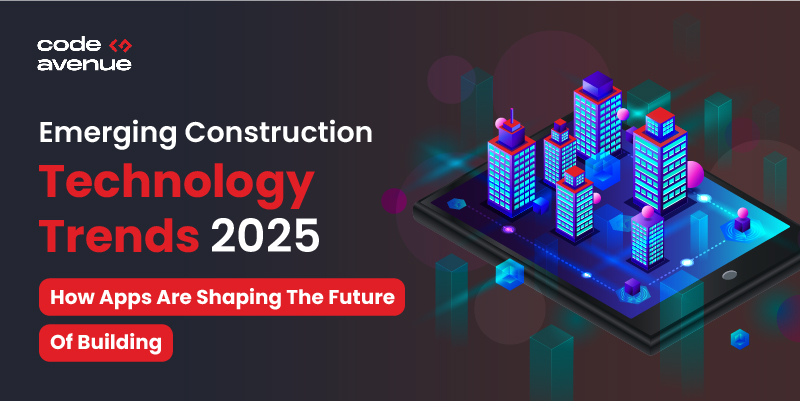Introduction
Modern technology leads a digital revolution in construction which drives improvements in both operational procedures and safety standards and environmental sustainability. The global construction technology market will exceed $10.34 billion by 2030 because of developments in artificial intelligence (AI) alongside robotics and both automation and mobile applications.
The rapid digital transformation results from the fact that more than 80% of construction companies are currently using mobile apps to manage their projects. Smart construction applications provide real-time team connectivity which reduces project delays by 30% while boosting operational efficiency by 40%.
Industry specialists with a construction technology degree execute a substantial improvement of both on-site safety protocols and risk management procedures. The applied construction technology logo represents app-driven solutions that serve as critical tools in sustainable development because they minimize waste production and maximize results.
What Are The Rising Construction Technology Trends In The Year 2025
- Smart Construction Apps: Revolutionizing Project Execution
Smart technology skills of a construction manager should be a top priority as they make project management more efficient through knowledge of automated process workflows and real-time data-driven collaboration among teams. Applications have proven vital for coordinated team efforts which result in decreased mistakes and project timelines remain punctual.
Real-Time Collaboration and Communication
- Modern cloud-based systems result in a 50% reduction in errors in construction technologies.
- Mobile apps and BIM collaboration allow better project coordination.
- IoT technology and wearable collaboration offer instant notifications for workers.
Enhancing Project Management and Workflow Efficiency
- AI scheduling tools optimize how resources are allocated in construction engineering technology.
- Digital documentation leads to enhanced operational speed at the workplace.
- Mobile invoicing software makes it possible to track costs in real-time.
- AI and Machine Learning: Transforming Construction Operations
AI together with machine learning is among the best construction technology examples that operate as a revolutionary force in construction to enhance decision processes along with risk evaluation procedures while monitoring construction sites. ML technologies analyze data patterns to schedule projects efficiently minimize budgets and maximize safety levels.
Predictive Analytics for Risk Mitigation
- AI models generate project delay predictions and deliver real-time modifications.
- ML algorithms review previous project data to prevent cost overruns.
- Pre-manufactured planning tools reduce resource waste and maximize performance.
Automated Site Monitoring for Safety and Efficiency
- AI drones perform instant site check-ups which leads to better compliance results.
- Smart sensors decrease both maintenance costs and downtime through early detection.
- Safety hazards become detectable through image recognition systems.
- BIM and Digital Twin Technology: Advancing Design and Construction
Building Information Modeling (BIM) and digital twin technology construction management technology teams obtain precise 3D design simulations for projects to see advancements and anticipate future issues while optimizing design plans ahead of construction. This is why construction technology jobs demand such high expertise, which is because of the number of skills required.
Enhanced 3D Modeling and Simulation
- BIM 8D models unite cost analysis with environmental programs and safety assessments.
- Digital twins display current building construction status and operational data in real time.
- AI simulations identify structural problems before building a physical project.
Augmented Reality (AR) and Virtual Reality (VR) Integration
- Design visualization through AR technology leads to a 40% reduction in errors.
- VR programs help workers improve their abilities while raising their overall safety.
- AR-assisted inspections streamline quality checks and defect detection.
- Robotics and Automation: The Future of Construction
Automation has transformed construction protocols which leads to improved precision while reducing labor requirements and speeding up project timelines. The on-site operations such as building construction and technology used for it continue to advance because of robotics and 3D printing. Building technology in construction has proven to be an effective method.
Autonomous Construction Equipment
- AI-powered robots use accurate algorithms to perform manual labor.
- Self-driving bulldozers and excavators improve both operational speed and effectiveness.
- Resource allocation through automated cranes eliminates human errors.
3D Printing in Construction
- 3D printing technology decreases the total construction duration by half.
- Environment-friendly materials decrease both expenses and greenhouse gas emissions.
- Digital printing equipment. Allow companies to create custom high-precision buildings.
- Sustainable Construction Technologies: Building a Greener Future
Modern construction technology and management focus on sustainability and have introduced breakthroughs that improve energy efficiency while minimizing waste and maximizing material usage. Digital construction technology management alongside smart systems implements environmentally friendly building practices. These are some of the advanced construction technologies.
Green Building and Energy Efficiency Apps
- Smart app tools enable optimal control of heating ventilation and air conditioning systems.
- AI systems select sustainable materials that decrease overall environmental impact.
- Smart water management systems serve as effective tools to protect valuable water resources.
Waste Reduction and Recycling Management
- The digital waste system helps execute environmentally responsible waste procedures.
- Blockchain technology provides maximum transparency and reduces material losses.
- Smart sorting solutions utilize automation to recycle and repurpose construction waste.
- Internet of Things (IoT): Enhancing Construction Monitoring
IoT technology transforms construction sites through real-time monitoring enhanced safety features and optimized resource allocation. Modern sensors and smart wearable technology help businesses establish safer and more effective workplace conditions. Developers might refer to Electric Technology Construction Inc. to create more effective and safer methods using IoT for workers.
Smart Sensors and Real-Time Monitoring
- A variety of IoT devices record environmental factors including temperature and humidity.
- The tracking sensors with equipment stop thefts and promote better fleet management.
- AI analytics systems enhance the functionality of equipment & minimize operational breakdowns.
Wearable Technology for Safety and Productivity
- Smart helmets detect hazardous conditions and deliver instant notifications.
- Wearable exoskeletons offer additional power and decrease exhaustion.
- Wearable technology monitors body signals to help prevent occupational injuries at work.
- Blockchain for Secure Transactions and Contract Management
Blockchain technology is among the examples of construction technology that has achieved enhanced security and transparency which enables automatic payments prevents fraud and speeds up contractual processes. Because of the expertise required for this role, the construction technology salary is also said to be among the highest. These are advancing construction technology careers.
Smart Contracts for Transparent Transactions
- Blockchain smart contracts automate payments while preventing contractual conflicts.
- Digital ledgers create transparent records for procurement and labor payment processes.
- The secure storing of records brings both trust and total manual processing elimination.
What Are The Best Practices For Investing In Construction Software Development
- Comprehend Business Purposes And Strategic Targets
Analyzing the main problem areas within your construction operations is one of the best practices used by Construtcion Technology Lbaoratories Inc. which makes sure you choose appropriate software. Select between existing ready-to-use solutions and new custom platform development solutions.
- Select A Construction Software Type
Businesses should pick software tools that match their specific industry needs such as project management and Building Information Modeling (BIM). The combination of these tools is often used by Avicado construction technology services, which many companies adopt.
- Focus On Flexibility And Effortless Junctions
Construction technology companies should use software that will grow alongside their project requirements. The adopted software needs to connect effortlessly with Enterprise Resource Planning (ERP) together with accounting software and cloud-based services to improve productivity.
- Prioritize Security And Regulatory Compliance
Full-scale security functions are mandatory for technology in the construction industry which safeguards business data while adhering to protocols. A secure system should feature end-to-end encryption together with multi-factor authentication in addition to compliance certifications to defend against cyber attacks.
- Examine Financial Expenses To Determine ROI
Analyze how software price models and licensing rates as well as support expenses and workers of building construction technology salary often match up to improve efficiency. The evaluation process will examine how this solution uses reduced rework to boost resource efficiency & better project deadlines.
- Perform Continuous Software Testings
Request or create demo versions with the help of construction document technology as well as trial periods before making a purchase decision to validate software performance alongside UX and integration compatibility. Make key stakeholders active members of the evaluation process to validate that the platform serves operational needs.
- Partner With Experienced Development Teams
Work together with technology construction specialists as the selection of a dependable partner demands capabilities in customization services, post-launch technical support, and ongoing updates. Working with experienced teams brings benefits that enable lasting adaptability and business success.
Conclusion
Modern technologies in construction have created a total transformation of project planning alongside management and execution procedures. Mobile apps lead the modern industrial transformation because of advancing AI together with automation and IoT and robotics systems that improve efficiency sustainability and profitability.
Do you need to create an advanced construction application? Bring your vision into reality through a partnership with Code Avenue. Reach out to us now to transform your construction workflows.
FAQs
What are the latest construction technology trends for 2025?
A combination of AI-based project management along with robotics and automation IoT-based monitoring and BIM advancements and blockchain-powered secure contracts comprises modern technological trends.
What is a construction technology in modern construction?
Construction technology in modern construction refers to the usage of all digital tools, software, and techniques that are used to improve the efficiency and sustainability of construction.
What should businesses consider before investing in construction software?
The success of such projects depends heavily on four main elements: scalability, system integration, security compliance, and the software’s ability to generate long-term investments.
What is the best construction management software for 2025?
Businesses adopt Procore alongside Autodesk BIM 360, and PlanGrid and create their own specialized software to match their organizational requirements.












They were willing to walk me through their ideas and provide suggestions when I wasn't sure about something.
Marcus Gitau Founder, Kumea, Agriculture Industry